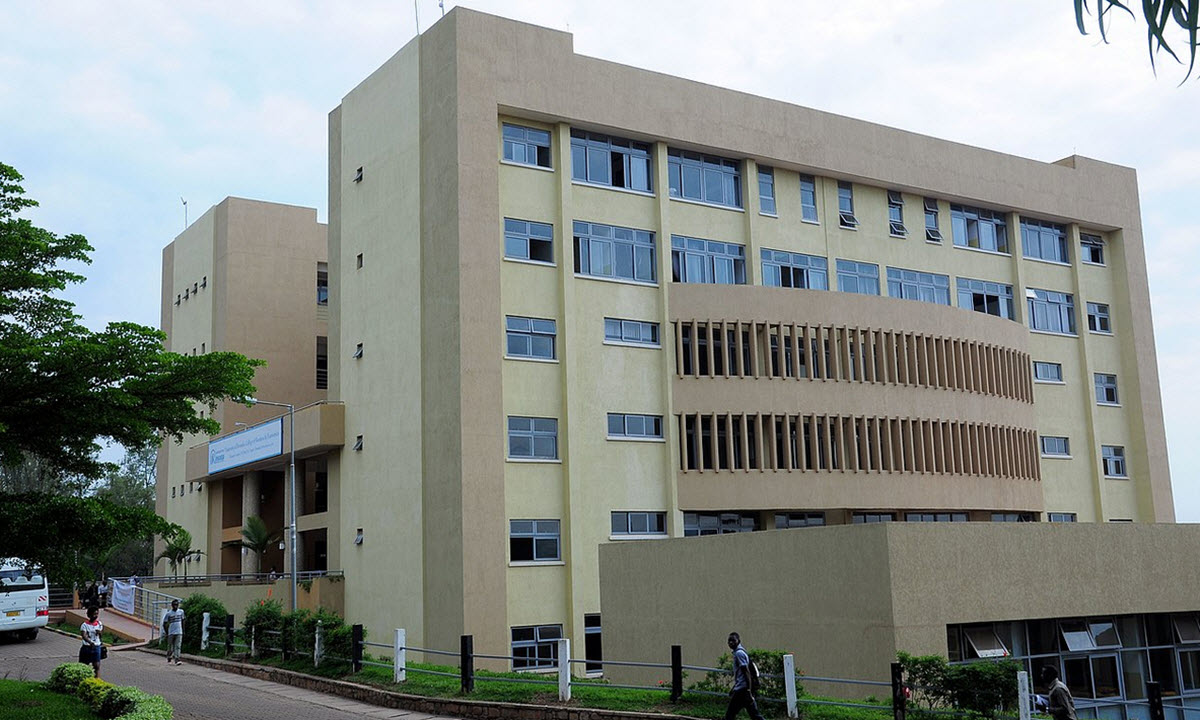Founded in September 2013, the University of Rwanda (UR) is a very new public university, but it has roots going back further than this since it was created through a merger of previously independent institutions of higher education in Rwanda, including the National University of Rwanda.
Ikinyarwanda name: Kaminuza y’u Rwanda
French name: Université du Rwanda
By early 2015, the University of Rwanda had 30,000+ enrolled students, of which 1,570 were postgraduates. Over 99% of the student body consisted of Rwandan nationals. At this point, the university employed 1,450 academics and 800+ support and administrative staff.

The first person to be awarded a PhD from the University of Rwanda was Agnes Binagwaho, whose doctoral research corcerned children´s health rights in the context of HIV/AIDS. She started her PhD work at Butare University in 2008 before the merger and recieved her PhD from the University of Rwanda in 2014. (She was the Permanent Secretary of the Ministry of Health of Rwanda in 2008-2011, and Minister of Health in 2011-2016).
Short facts about the University of Rwanda
Location
Address : KK 737 Street, Gikondo, Kigali
Kigali is Rwanda´s capital and largest, and it is located near the country´s geographic centre.
Language
English
Colours
Blue
International collaborations
The university participates in a number of international collaborations, including a joint MSc degree programme in agribusiness run in collaboration with the Michigan State University, with funding from the United States Agency for International Development.
Colleges
The University of Rwanda contains six colleges:
- College of Arts and Social Sciences (CASS)
Koleji yigisha iby’Indimi n’Ubumenyi bw’Imibereho y‘Abaturage - College of Agriculture, Animal Sciences and Veterinary Medicine (CAVM)
Koleji y’Ubuhinzi, Ubumenyi n‘ubuvuzi bw‘Amatungo - College of Business and Economics (CBE)
Koleji yigisha iby’Ubucuruzi n’Ubukungu - College of Education (CE)
Koleji Nderabarezi/Collège de l’Education) - College of Medicine and Health Sciences (CMHS)
Koleji y’Ubuvuzi n’Ubuzima - College of Science and Technology (CST)
Koleji y‘Ubumenyi n‘Ikoranabuhanga
Campuses
The university has 14 campuses:
- Busogo Campus
- Byumba Campus
- Gikondo Campus
- Huye Campus (Butare)
- Kibungo Campus
- Kicukiro Campus
- Musanze Campus
- Nyagatare Campus
- Nyamishaba Campus
- Nyarugenge Campus
- Remera Campus
- Rubirizi Campus
- Rukara Campus
- Rusizi Campus
History
The University of Rwanda was established in September 2013, when Law number 71/2013 merged seven institutes of higher education to form the new university.
- The National University of Rwanda (UNR)
- The Kigali Institute of Science and Technology (KIST)
- The Kigali Institute of Education (KIE)
- The Higher Institute of Agriculture and Animal Husbandry (ISAE)
- The School of Finance and Banking (SFB)
- The Higher Institute of Umutara Polytechnic (UP)
- The Kigali Health Institute (KHI)
The National University of Rwanda (French: Université nationale du Rwanda)
The largest of the seven institutions that merged in 2013 to form the University of Rwanda was the National University of Rwanda.
The National University of Rwanda (NUR) was established in 1963 by the government in collaboration with the Congregation of the Dominicans from the Province of Quebec, Canada. Its first rector was the Dominican priest and sociologist Father Georges-Henri Lévesque from Quebec, and French was the language of instruction.
The university was located in Butare in southern Rwanda, and Butare is still to this day and important university city in Rwanda due to the presence of the University of Rwanda Butare Campus.
When it was first established, the university had 51 students and 16 lecturers, spread out over three divisions: the Faculty of Medicine, the Faculty of Social Sciences and the Teacher Training College.
When the university was re-opened in 1995 after the Rwandan Genocide of 1994, English was introduced as a language of instruction alongside French.
Examples of notable alumni
- Pasteur Bizimungu, former President of Rwanda
- Dr Pierre Habumuremyi, former Prime Minister of Rwanda
- Edouard Ngirente, Prime Minister of Rwanda since 2017
- Vincent Biruta, Minister of Foreign Affairs in Rwanda since 2019
- Louise Mushikiwabo, Secretary General of La Francophonie, former minister of foreign affairs in Rwanda
- Bernard Makuza, former President of the Senate in Rwanda
- Jean Damascène Ntawukuliryayo, former President of the Senate in Rwandan
- Rose Mukantabana, first female Speaker of the Chamber of Deputies
- Alice Rwema, vice chairperson and company secretary of Rwanda Energy Group
- Cyprien Ntaryamira, former President of Burundi
- Domitien Ndayizeye, former President of Burundi